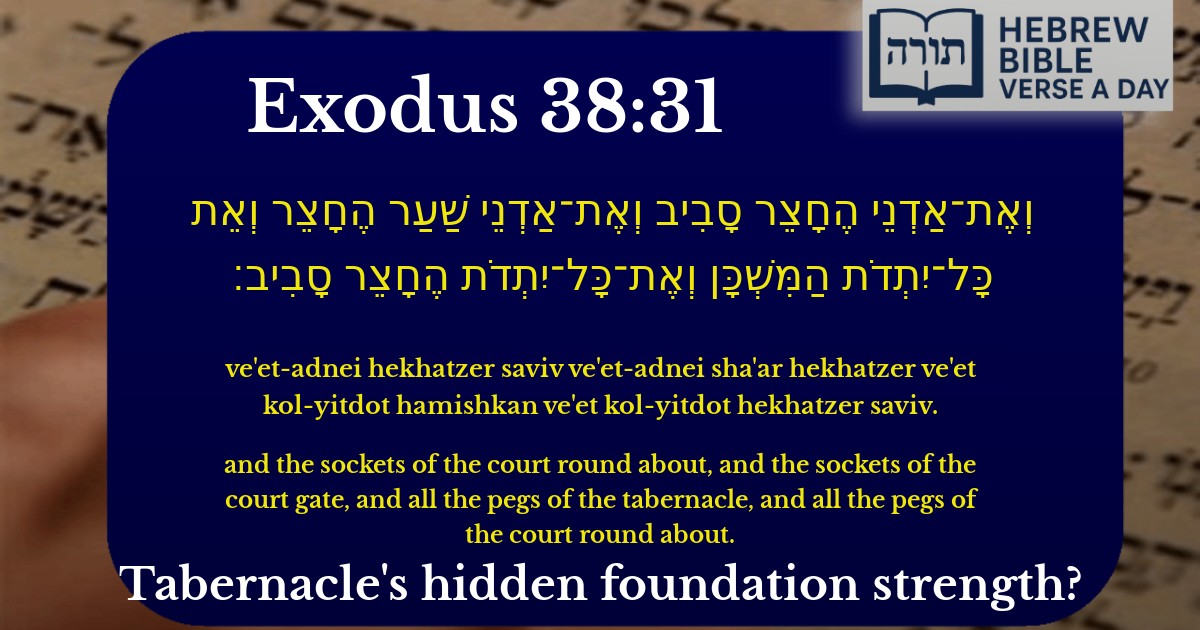Join Our Newsletter To Be Informed When New Videos Are Posted
Join the thousands of fellow Studends who rely on our videos to learn how to read the bible in Hebrew for free!
Hebrew Text
וְאֶת־אַדְנֵי הֶחָצֵר סָבִיב וְאֶת־אַדְנֵי שַׁעַר הֶחָצֵר וְאֵת כָּל־יִתְדֹת הַמִּשְׁכָּן וְאֶת־כָּל־יִתְדֹת הֶחָצֵר סָבִיב׃
English Translation
and the sockets of the court round about, and the sockets of the court gate, and all the pegs of the tabernacle, and all the pegs of the court round about.
Transliteration
Ve'et-adnei hekhatzer saviv ve'et-adnei sha'ar hekhatzer ve'et kol-yitdot hamishkan ve'et kol-yitdot hekhatzer saviv.
Hebrew Leining Text
וְאֶת־אַדְנֵ֤י הֶֽחָצֵר֙ סָבִ֔יב וְאֶת־אַדְנֵ֖י שַׁ֣עַר הֶחָצֵ֑ר וְאֵ֨ת כׇּל־יִתְדֹ֧ת הַמִּשְׁכָּ֛ן וְאֶת־כׇּל־יִתְדֹ֥ת הֶחָצֵ֖ר סָבִֽיב׃
Parasha Commentary
📚 Talmud Citations
This verse is not quoted in the Talmud.


Context in the Construction of the Mishkan
The verse (Exodus 38:31) details the completion of the Mishkan's structural components, specifically mentioning the sockets (adanim) of the courtyard and the pegs (yitdot) used to secure the Mishkan and its surrounding enclosure. According to Rashi, these elements were essential for stabilizing the Mishkan's structure, ensuring it remained upright and functional during the Israelites' travels in the wilderness.
The Significance of the Sockets (Adanim)
The sockets served as foundational supports for the beams of the courtyard. The Midrash Tanchuma (Pekudei 11) emphasizes that these sockets, made from the donated silver of the Israelites, symbolized the unity and collective contribution of the nation toward the Mishkan's construction. Rambam (Hilchot Beit HaBechirah 1:15) later draws parallels between the Mishkan's sockets and the foundations of the Beit HaMikdash, highlighting their role in sanctity and permanence.
The Role of the Pegs (Yitdot)
The pegs were used to anchor the Mishkan's curtains and the courtyard's hangings to the ground. The Talmud (Yoma 72a) compares these pegs to the "nails of the Torah," suggesting that just as the pegs secured the physical structure, Torah study and mitzvot anchor a Jew's spiritual life. The Sforno adds that the pegs' durability reflects the enduring nature of the covenant between Hashem and Israel.
Symbolism of the Court and Its Gate
Practical Lessons from the Verse
The meticulous accounting of these components, as emphasized in the parsha of Pekudei, teaches the value of transparency and integrity in communal projects (Rashi on Exodus 38:21). Additionally, the Or HaChayim highlights that every detail of the Mishkan reflects the divine blueprint, reinforcing the idea that even seemingly minor mitzvot contribute to a greater spiritual structure.